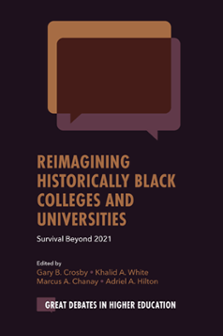
Index
Reimagining Historically Black Colleges and Universities
ISBN: 978-1-80043-665-7, eISBN: 978-1-80043-664-0
Publication date: 26 May 2021
Citation
(2021), "Index", Crosby, G.B., White, K.A., Chanay, M.A. and Hilton, A.A. (Ed.) Reimagining Historically Black Colleges and Universities (Great Debates in Higher Education), Emerald Publishing Limited, Leeds, pp. 197-201. https://doi.org/10.1108/978-1-80043-664-020211018
Publisher
:Emerald Publishing Limited
Copyright © 2021 by Emerald Publishing Limited
INDEX
- Prelims
- Chapter 1 An Anchored Look Forward
- Chapter 2 The History of HBCUs: Lessons on Innovation from the Past
- Chapter 3 Don't Believe the Hype: HBCUs and MSIs Are Still Necessary to Black Political and Socioeconomic Development and Advancement
- Chapter 4 HBCUs in a New Decade: A Look at 2010 to 2020 and Beyond
- Chapter 5 HBCUs: The Foundation and Future of Social Justice, Leadership, and Leadership Development
- Chapter 6 Using THRIVE as a Framework for Creating HBCU Success Stories
- Chapter 7 Philanthropy versus Fundraising – An Imperative for HBCUs
- Chapter 8 Financial Issues for HBCUs in 2020 and Beyond
- Chapter 9 Sharpening a Competitive Edge: How HBCUs Leverage Their Strengths with Strategic Partnerships
- Chapter 10 Adaptive Survival Strategies: A Case Study Analysis of Four Historically Black Colleges and Universities
- Chapter 11 Answering the Call: The Role of HBCUs in Engaging Black Women's Identity Politics
- Chapter 12 Current Trends, Future Directions: Promoting the Long-Term Survival and Success of HBCUs
- Chapter 13 Democracy Matters in the 21st Century HBCU Writing Classroom: AfriWomanism as a Political, Pedagogical Tool
- Chapter 14 The Category Is…Transformational Inclusion: A Conceptual Framework for (Re)imagining the Inclusion of Black Queer and Trans* Students Attending HBCUs
- Chapter 15 The Usage of Personal Power When Collaborating with Black Male Scholars at a Historically Black College and University
- Chapter 16 The Reasons for Reimagining
- Epilogue
- About the Editors
- About the Contributors
- Index